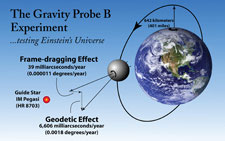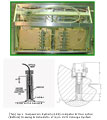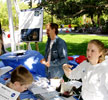WEEKLY UPDATE FOR 15 APRIL 2005:
GRAVITY PROBE B MISSION STATUS AT A GLANCE

| Item | Current Status |
| Mission Elapsed Time | 360 days (51 weeks/11.80 months) |
| Science Data Collection | 231 days (33 weeks/7.57 months) |
| Current Orbit # | 5,316 as of 9:00 PM PST |
| Spacecraft General Health | Good |
| Roll Rate | Normal at 0.7742 rpm (77.5 seconds per revolution) |
| Gyro Suspension System (GSS) | All 4 gyros digitally suspended in science mode |
| Dewar Temperature | 1.82 kelvin, holding steady |
| Global Positioning System (GPS) lock | Greater than 96.0% |
| Attitude & Translation Control (ATC) | X-axis attitude error: 140.5 marcs rms |
| Command & Data Handling (CDH) | B-side (backup) computer in control Multi-bit errors (MBE): 0 Single-bit errors (SBE): 6 (daily average) |
| Telescope Readout (TRE) | Nominal |
| SQUID Readouts (SRE) | Nominal |
| Gyro #1 rotor potential | -5.0 mV |
| Gyro #2 rotor potential | -6.3 mV |
| Gyro #4 rotor potential | -5.4 mV |
| Gyro #3 Drag-free Status | Backup Drag-free mode (normal) |
MISSION DIRECTOR'S SUMMARY
As of Mission Day 360, the Gravity Probe B vehicle and payload are in good health. All four gyros are digitally suspended in science mode. The spacecraft is flying drag-free around Gyro #3.

Around February of this year, we entered a GP-B “season” where the front of the spacecraft is pointing towards the sun. Many of the electronics boxes on-board the spacecraft are located in the Forward Equipment Enclosure (FEE), and we are in the process of investigating the possibility that the spacecraft's sunward orientation may be a contributing factor to the increase in multi-bit errors (MBEs) we experienced a few weeks ago, as well as some of the attitude control issues we have experienced recently—especially in the South Atlantic Anomaly (SAA) region.
This past week, we made further progress operating the spacecraft through the SAA region. In analyzing the SAA attitude data we have collected recently, our ATC group noticed some interesting patterns. They have now investigated these patterns and determined that a data type conversion routine was causing data values exceeding a certain threshold to become corrupted. This situation was greatly exacerbated in the SAA region, where the telescope's detectors were being flooded with stray protons, which causes a noticeable increase in these corrupted data values.

As reported in last week's update, we addressed these SAA attitude problems by shrinking our defined size of the SAA region and reducing the gains on both the ATC system and the telescope detectors. These gain reductions have provided a work-around for this data corruption problem by re-scaling the data values so that they no longer exceed the threshold in the SAA region. As a result, our spacecraft can now point at the guide star throughout the SAA region with the same precision as it does outside the SAA.
Also last week, we exercised the Ultraviolet Discharge procedure on science gyros #1, #2, and #4, followed later by drag-free gyro #3. This procedure reduces the electrostatic charge that builds up on the gyro rotors over time. The rotors build up a charge in two ways: first, the process of suspending the rotors electrically deposits some charged particles on them, and second, protons from the sun are constantly bombarding the spacecraft, especially over the SAA region, and some of these protons strike the rotors and leave a residual charge on them.

We use ultraviolet light to remove the build-up of electrostatic charge from the gyro rotors. Each gyro housing is fitted with fiber optic cables that run from the gyro housings, up through the top hat of the probe and out to an ultraviolet light source in the Experiment Control Unit (ECU) box, mounted on the spacecraft frame. Ultraviolet light is beamed through the fiber optics onto the gyro rotors to discharge them. When the ultraviolet lamps are turned on, electrons form a plasma between the electrode and the rotor surface. By changing the bias on these electrodes, we can control the direction of electron flow, either towards or away from the surfaces of the rotors.
Reducing the level of charge on the gyro rotors decreases the amount of voltage required to suspend them, thus minimizing any torques (forces) applied to the rotors by the Gyro Suspension System (GSS). In other words, this procedure increases the sensitivity and accuracy of the GSS by ensuring that we are using the minimum voltage required to suspend the gyro rotors in their housings.
Finally, this past week, we began planning for another heat pulse test to determine the level of liquid helium remaining in the Dewar. We also continued our detailed planning for the post-science instrument re-calibration phase, estimated to begin early in July.
MISSION NEWS—GRAVITY PROBE B EXHIBIT AT STANFORD'S COMMUNITY DAY
From 10:00 AM to 4:00 PM this past Sunday, 10 April 2005, Stanford University hosted its 4th annual Stanford Community Day—an all-day open house featuring music, arts, athletic events, science exhibits, faculty lectures and a health fair. Community Day is designed to promote partnerships and increase understanding among Stanford and its neighbors, especially the residents of the surrounding communities. An estimated 10,000-12,000 people attended the event this year. All activities were open to the public and free of charge.
 As we have done for the past three years, Gravity Probe B set up a hands-on exhibit space under a 40-foot square tent. Coordinated by GP-B Educational Outreach Coordinator, Shannon Range, this year's exhibit was the biggest and best yet. Over the years, Shannon has developed a number of hands-on activities that he uses in workshops with teachers and students to explain various concepts of general relativity and the technologies involved in the GP-B experiment. For Community Day, Shannon set up several of these activities at different stations under the GP-B tent, and more than 30 GP-B team members took turns staffing these stations throughout the day. These stations included:
As we have done for the past three years, Gravity Probe B set up a hands-on exhibit space under a 40-foot square tent. Coordinated by GP-B Educational Outreach Coordinator, Shannon Range, this year's exhibit was the biggest and best yet. Over the years, Shannon has developed a number of hands-on activities that he uses in workshops with teachers and students to explain various concepts of general relativity and the technologies involved in the GP-B experiment. For Community Day, Shannon set up several of these activities at different stations under the GP-B tent, and more than 30 GP-B team members took turns staffing these stations throughout the day. These stations included:
- Gyros Table—A table full of various types of gyroscopes and tops for people to experiment with. There were toy gyros with pull strings, plastic liquid-filled gyros, various kinds of spinning tops, low-friction gyros that spin for a very long time, and a heavy brass gyro that our team members spun up using a motorized grinding tool with a rubber tip. Once spinning, this brass gyro strongly resists attempts to change its orientation.


- Escaping Gravity Trampoline—While jumping on a small exercise trampoline, exhibit visitors were directed to drop a tennis ball at the high point of their jump and notice that for an instant, you could see the person and ball free-falling at the same rate. (For a more dramatic version of this experiment, try placing a coin on your knee and watch it hover over your knee as you fall 20 stories in an amusement park ride, such as Drop Zone at Great America.)
- Bicycle Wheel Gyro & Turntable—Standing on a rotating platform (or sitting in a swivel chair), a person holds a spinning bicycle wheel that has been outfitted with handles on either side. When the wheel is spun, it becomes a gyroscope, and turning the spinning wheel causes you to spin around on the platform or in the chair.




- Spandex Spacetime—A large sheet of spandex cloth is stretched and secured over a cylindrical PVC frame, simulating spacetime in 3 dimensions. A large rubber ball placed in the center of the sheet simulates a planet, such as Earth, that makes a warp or dent in the otherwise flat surface. When small marbles or ball bearings are rolled across the spandex sheet, they follow the curvature of the warped, spandex spacetime. Visitors are challenged to roll the marbles in such a way as to get them “orbiting” around the heavy rubber ball in the center. You can simulate a very massive body in spacetime by placing a bowling ball in the center of the spandex sheet.
- Splitting a Light Beam—This apparatus and activity made its debut at Community Day this year. A member of our GP-B telescope group set up a laser beam and a roof prism on an optical platform. The roof prism was surrounded by a substance called aerogel, that enables you to see the path of the laser beam as it strikes the prism. Photo detectors, placed on either side of the prism, are connected to readout displays, which indicate the amount of light emanating from each half of the prism. The goal of this activity is to look down on the edge of the prism's roof and, using a very fine adjustment knob, manually adjust the position of the prism until it appears that the light beam is split exactly in half. You can then view the readout meters to see how close you came.


 In addition to these hands-on activities, we had many GP-B objects on display, including a set of flight-ready GP-B gyroscopes and housings, a flight-backup science instrument assembly (the part of the GP-B probe that includes the telescope and quartz block housing the gyros), scale models of the GP-B spacecraft, (including our paper model that you can download here and assemble yourself), and a large cutaway model of the GP-B Dewar. We also had an 8-foot long timeline of the GP-B program and mission, as well as various other explanatory panels placed throughout the tent. For people who wanted to sit down and rest a bit, we set up a small theatre, where we alternately showed the 26-minute movie, “Testing Einstein's Universe,” produced by Norbert Bartel, Professor of Astrophysics & Space Science at York University in Toronto, Canada, and a 12-minute video of the GP-B launch, edited by Video Producer Mick Speer at NASA's Marshall Space Flight Center.
In addition to these hands-on activities, we had many GP-B objects on display, including a set of flight-ready GP-B gyroscopes and housings, a flight-backup science instrument assembly (the part of the GP-B probe that includes the telescope and quartz block housing the gyros), scale models of the GP-B spacecraft, (including our paper model that you can download here and assemble yourself), and a large cutaway model of the GP-B Dewar. We also had an 8-foot long timeline of the GP-B program and mission, as well as various other explanatory panels placed throughout the tent. For people who wanted to sit down and rest a bit, we set up a small theatre, where we alternately showed the 26-minute movie, “Testing Einstein's Universe,” produced by Norbert Bartel, Professor of Astrophysics & Space Science at York University in Toronto, Canada, and a 12-minute video of the GP-B launch, edited by Video Producer Mick Speer at NASA's Marshall Space Flight Center.



However, as has been the case at Community Day in past years, the most popular place in GP-B exhibit tent was our GP-B Information table. Here, several GP-B scientists and engineers took shifts answering questions about the GP-B mission, the experiment, the technology, general and special relativity, Newtonian physics, and many other related (and unrelated) topics. We gave away 500 toy gyroscopes at this table, along with mission stickers, spacetime posters, GP-B Fact Sheets, and other informational materials. We don't know exactly how many people visited our exhibit, but it was well over a thousand. The give-away gyros were all gone by noon, and the tent was literally packed all day. All the members of our GP-B team who helped throughout the day reported having a great time.
UPDATED NASA/GP-B FACT SHEET AVAILABLE FOR DOWNLOADING
We recently updated our NASA Factsheet on the GP-B mission and experiment. You'll now find this 6-page document (Adobe Acrobat PDF format) listed as the last navigation link under "What is GP-B" in the upper left corner of this Web page. You can also click here to download a copy.
THE EINSTEIN EXHIBITION AT THE SKIRBALL CULTURAL CENTER IN LOS ANGELES
 If you're going to be in Los Angeles anytime before 30 May 2005, and if you’re interested in Einstein’s life and work, the Einstein Exhibition at the Skirball Cultural Center (just north of the Getty Museum on Interstate 405) is the most comprehensive presentation ever mounted on the life and theories of Albert Einstein (1879-1955). It explores his legacy not only as a scientific genius who re-configured our concepts of space and time, but also as a complex man engaged in the social and political issues of his era. It examines the phenomenon of his fame and his enduring status as a global icon whose likeness has become virtually synonymous with genius.
If you're going to be in Los Angeles anytime before 30 May 2005, and if you’re interested in Einstein’s life and work, the Einstein Exhibition at the Skirball Cultural Center (just north of the Getty Museum on Interstate 405) is the most comprehensive presentation ever mounted on the life and theories of Albert Einstein (1879-1955). It explores his legacy not only as a scientific genius who re-configured our concepts of space and time, but also as a complex man engaged in the social and political issues of his era. It examines the phenomenon of his fame and his enduring status as a global icon whose likeness has become virtually synonymous with genius.
In this exhibit, you can examine Einstein's report card, inspect his FBI file, and enjoy his family photographs, love letters, and diary entries. Exhibition highlights include scientific manuscripts and original correspondence—including original handwritten pages from the 1912 manuscripts of the special theory of relativity and his 1939 letter to President Roosevelt about nuclear power—and a wealth of other documents from the Albert Einstein Archives at the Hebrew University of Jerusalem.



In addition to these displays of Einstein memorabilia, the exhibit also features a number of interactive components that help provide an understanding of Einstein's revolutionary theories. Furthermore, several “explainers,” identified by their red aprons, are on hand to discuss various aspects of the exhibit and to explain and demonstrate difficult concepts, such as time dilation and warped spacetime. At the end of the exhibit, you’ll find one of GP-B’s gyro rotors on display.
The Einstein exhibition was jointly organized by the American Museum of Natural History (AMNH), the Hebrew University of Jerusalem, and the Skirball Cultural Center. It was designed by the AMNH under the supervision of Dr. Michael Shara, curator of the exhibit and chairman of the museum’s Astrophysics Department. It opened in November 2002 at the AMNH in New York and then traveled to Chicago and Boston, spending about 8 months in each location. It will remain at its final U.S. stop at the Skirball Center in Los Angeles through 29 May 2005, after which time it will move permanently to the Hebrew University in Jerusalem.
Information about the Einstein exhibition is available on the Skirball Center Web site. If you can’t make it to Los Angeles, you can visit the AMNH’s virtual Einstein exhibit on the Web.
Drawings and photos: The diagrams of the GP-B experiment and the Seasons of GP-B were created by GP-B Public Affairs Coordinator, Bob Kahn. The drawing of the South Atlantic Anomaly (SAA) region, the drawings of the gyro rotor UV discharge system and the photo of the Gyro Suspension System (SS) electronics are from the GP-B Photo & Graphics Archive here at Stanford. The photos taken in the GP-B exhibit tent on Stanford Community Day were taken by GP-B Educational Outreach Coordinator, Shannon Range and GP-B Public Affairs Coordinator, Bob Kahn. The photos from the Einstein Exhibit are courtesy of the Skirball Cultural Center. Click on the thumbnails to view these images at full size.
MORE LINKS ON RECENT TOPICS
- Track the satellite in the sky
- Photo, video & and news links
- Build a paper model of the GP-B Spacecraft
- Following the mission online
- Our mailing list - receive the weekly highlights via email
- The GP-B Launch Companion in Adobe Acrobat PDF format. Please note: this file is 1.6 MB, so it may take awhile to download if you have a slow Internet connection.
Previous Highlight
Index of Highlights


